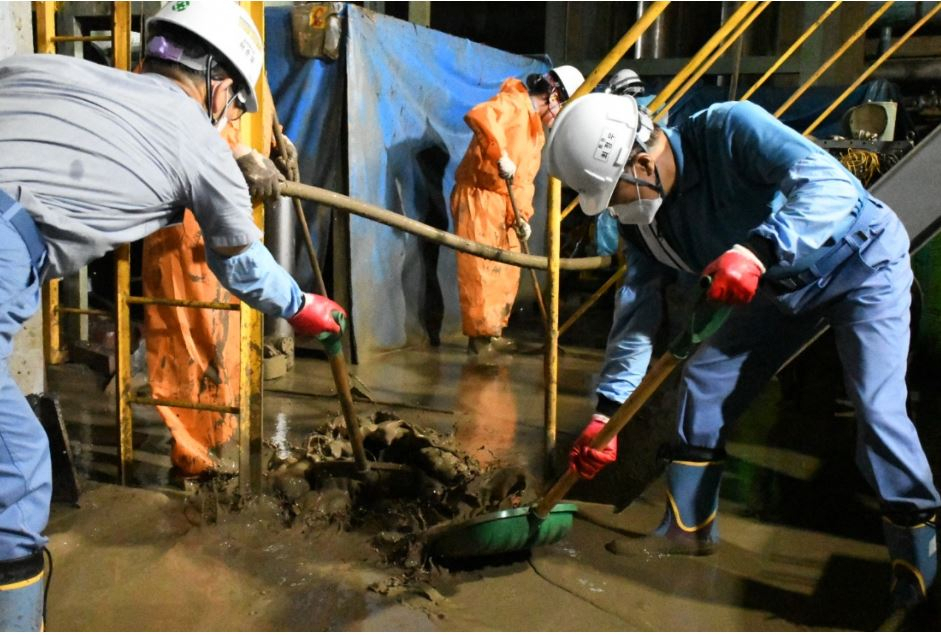Market Now
[From the scene] Typhoon-hit Posco mill in Pohang comes back stronger
 |
A slab, or crude steel, heads to a rolling station in Posco's No. 2 hot strip plant in Pohang, North Gyeongsang Province on Dec. 15. The company started operations of its second hot strip plant for the first time since shutting down on Sept. 6 due to Typhoon Hinnamnor submerging the plant's facilities underwater. (Posco) |
POHANG, North Gyeongsang Province -- Some 7,000 metric tons of molten iron at 1,200 degrees Celsius and consisting of smelted iron ore, coke and limestone is poured from a gigantic industrial ladle into a furnace to be purified at Posco's steel mill.
The purified molten steel is then poured into molds, where water vapor rises with deafening hisses as the iron is instantly cooled.
Semi-finished materials, called slabs, become visible as the water vapor dissipates. They are quickly moved along on conveyor belts to a rolling station, where they are forged into finished steel products.
"Today marks the 99th day since Posco's No. 2 hot strip plant resumed its normal operations. When we succeeded in producing the first product, I shouted 'Hooray!' with the staff, ran out, and wept," said Lee Hyun-chul, tearing up during a press conference held at Posco's Pohang steel mill on Thursday. Lee is the manager of Posco's No. 2 hot strip plant, which is currently responsible for a third of the South Korean steelmaker's entire production, producing some five million tons of steel products annually.
"The whole restoration process was a miracle. Experts have said that the restoration process would take more than a year to complete, but we've finished it in 135 days," said Lee.
Resumption of normal operations at Posco’s steelmaking facilities comes in the aftermath of Typhoon Hinnamnor in September of last year. The typhoon’s record-breaking rain submerged the plant due to a nearby stream overflowing, causing the plant to shut down for the first time in its 49-year history.
According to Posco, when the typhoon hit, the plant had been filled with water up to 1.5 meters high. Draining the water from the facilities alone had taken four weeks. Even after draining the water, Posco officials added that 30 centimeters of mud had to be pumped out over the course of two weeks.
 |
Posco Group Chairman Choi Jeong-woo (right) clears out mud at a rolling mill on Sept. 18 in the aftermath of a typhoon. (Posco) |
As a result of some 1.4 million people’s efforts, including those of Posco employees ranging from the chairman, executives and even retired employees working alongside firefighters and marines, the steel mill's main facilities such as blast furnaces -- which have to operate 24/7 in order to prevent unused molten iron from solidifying -- were restored in six days. Hot strip plants within the mill were restored in just three months.
The whole steel mill was restored as of Jan. 20, some four months after the typhoon halted its operations.
To prevent recurrences, Posco said it is establishing thorough preventative measures. In order to block inflows of water, Posco is currently constructing a 1.9-kilometer water barrier outside the factory. The company also said it is embedding sheet piles along the sides of the nearby stream to further prevent it from overflowing.
For its plans going forward, Posco said it is putting in efforts to make the steel mill "smarter" by incorporating eco-friendly and artificial intelligence-run processes.
In Posco's No. 2 blast furnace control room in the steel mill, employees sat in a room full of screens to remotely oversee the condition of each blast furnace. They watched as an AI system called "PosPLOT" calculated the appropriate amount of iron ore and coal that had to be put into the blast furnaces to optimize the quality of molten iron inside.
"After applying the smart furnace in 2019, annual production increased by 85,000 tons, and the defect rate of molten iron decreased from 13.3 percent to 4.9 percent. The whole procedure also became safer, with people viewing the situation remotely in control rooms," said Choi Myung-seok, the head of Posco's No. 2 blast furnace.
"We were able to restart the Pohang steel mill with the help of many people. Now, we will return to (developing) smart technologies so that we can improve our competitiveness and return the favor," said Cheon Si-yeol, head of Posco's steel production technology strategy office.
By Lee Yoon-seo (yoonseo.3348@heraldcorp.com)


![[Global Finance Awards] Mirae Asset Securities' global top-tier ambition within reach](http://res.heraldm.com/phpwas/restmb_idxmake.php?idx=151&simg=/content/image/2024/11/27/20241127050077_0.jpg)
![[Global Finance Awards] Kyobo Life enhances insurance coverage for cancer, long-term care](http://res.heraldm.com/phpwas/restmb_idxmake.php?idx=151&simg=/content/image/2024/11/26/20241126050106_0.jpg)
![[Global Finance Awards] Kakao Bank bolsters SE Asia foray with Superbank partnership](http://res.heraldm.com/phpwas/restmb_idxmake.php?idx=151&simg=/content/image/2024/11/27/20241127050076_0.jpg)
![[Global Finance Awards] IBK boosts support for small businesses](http://res.heraldm.com/phpwas/restmb_idxmake.php?idx=151&simg=/content/image/2024/11/27/20241127050072_0.jpg)
![[Global Finance Awards] Shinhan chief pushes to boost corporate value](http://res.heraldm.com/phpwas/restmb_idxmake.php?idx=151&simg=/content/image/2024/11/27/20241127050074_0.jpg)
![[Global Finance Awards] Mirae Asset bolsters global presence with W370tr under management](http://res.heraldm.com/phpwas/restmb_idxmake.php?idx=151&simg=/content/image/2024/11/27/20241127050075_0.jpg)
